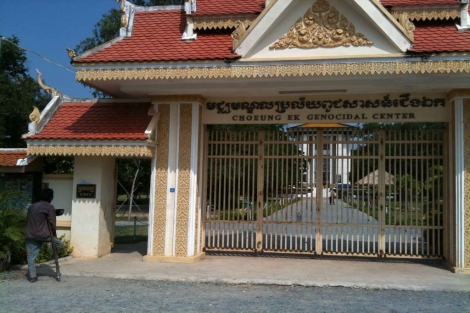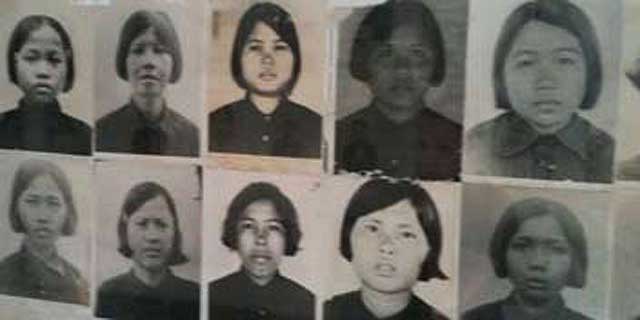The atlas of pain, in those places where human beings to be waived, where no turns, a notch of infamy and death Phnom Penh and halo defines the memory of Pol Pot (1925-1998). Born on a day like today 86 years ago, the architect of the Khmer Rouge miserable and ultimately responsible for atrocities committed between 1975 and 1979 by these "Nazis of Asia", in defining the reporter Sydney Schanberg, survives symbolically in the Cambodian capital encrypted on a journey of horror: the driving Museum at Tuol Sleng Genocide Memorial extermination camp of Choeung Ek.
Only 17 miles separate the first, detention and torture center known as S-21, Choeung Ek, the great slaughter of the suburbs. Both ruled with a heart of lead Kaing Guek Eav, alias 'Comrade Duch'. The arm of the horde led by Pot was sentenced last July to 30 years in prison after being found guilty of war crimes and crimes against humanity, murder and torture.
It was the first verdict against one of the leaders of the most paranoid dictatorship in history. The same fate may be at Nuon Chea, Ieng Sary, Khieu Samphan and Ieng Tirith, four leaders who from this week and know they will be judged on 27 June. An estimated 15,000 people (including 2,000 children) of the nearly two million people killed in Democratic Kampuchea, the official name of that delirious state of Maoist court, passed through the sinister Duch stays in the village of Phnom Penh.
Not a single guide looks at the old jail, and before that, high-school, or in the garbage heap of suburbs. There, no one goes on vacation, even for morbidity. In any case, it may be a journey to self-fund, which burns exorcism. Tuol Sleng, as a tropical ESMA, keeps even the barbed wire on its walls.
"Do not play dumb saying he does not understand the question, you are brave enough to acknowledge that opposes the revolution," says the third section of the consensus of a model prisoner, then and now visible on a giant poster. "It is absolutely forbidden to mourn when beaten or electrocuted," urges the sixth 'commandment'.
In four blocks of medium height and architecture poor distributed improvised interrogation rooms and supervised by Guek Eav martyrdom. His last 14 victims, one of them a woman, lie precisely in several tombs arranged in the main courtyard in front where they were found at the very moment of liberation from prison.
Rooms and more rooms will happen at the beginning of the route with the same criminal scenery: the iron skeleton of a cot ready for the torture tools (handles, chains, electrodes), a wreath ... And like a brutal animal care, photography itself the little room with its last tenant bloodless.
Between drywall and tile to tables show the visitor the pain of several generations. Children, teenagers, men, women, seniors, pictures and even some foreign regime ... All strange faces that look without fear of eyes in portraits of police record, guilty only of not participating in an unprecedented folly in the extreme South Asian.
Complete the list of monstrosities, with the bottom-palm entire rooms divided into cells, niche and gym hoops ready for immolation. There were prisoners that were broken at such martyrdom and chose to die by themselves. Brokers access to higher cells, located on the third floor, had to be lined with spikes to prevent suicides.
Nothing comparable, in spite of everything, with the chills that causes a stroll through the Choeung Ek Memorial. Attest to this the 8,000 skulls are displayed to the public stacked and sorted on site. In glass cases and along with human remains on display also hundreds of shirts, scarves and pants.
Were extracted from the earth and disinfected to help contextualize such horror. Other articles, however, still appear today in the grass and mud to the astonishment of any foreign visitor, the gigantic mass grave they were thrown their owners. Anonymous gravestones are broken lives fabric to shreds.
Because of the disabled who ask for a dollar at the entrance to the campus, originally a Chinese cemetery today presided over by a Buddhist stupa. Infamous Trail of the Khmer Rouge can be seen even in Banteay Kdei, one of the holy temples of Angkor, and in the city of Siem Reap. On its walls, studded with scenes of apsaras or dancers successive downloaded militants target practice.
Then, as Pot himself, disappeared forever in the jungle. 


Only 17 miles separate the first, detention and torture center known as S-21, Choeung Ek, the great slaughter of the suburbs. Both ruled with a heart of lead Kaing Guek Eav, alias 'Comrade Duch'. The arm of the horde led by Pot was sentenced last July to 30 years in prison after being found guilty of war crimes and crimes against humanity, murder and torture.
It was the first verdict against one of the leaders of the most paranoid dictatorship in history. The same fate may be at Nuon Chea, Ieng Sary, Khieu Samphan and Ieng Tirith, four leaders who from this week and know they will be judged on 27 June. An estimated 15,000 people (including 2,000 children) of the nearly two million people killed in Democratic Kampuchea, the official name of that delirious state of Maoist court, passed through the sinister Duch stays in the village of Phnom Penh.
Not a single guide looks at the old jail, and before that, high-school, or in the garbage heap of suburbs. There, no one goes on vacation, even for morbidity. In any case, it may be a journey to self-fund, which burns exorcism. Tuol Sleng, as a tropical ESMA, keeps even the barbed wire on its walls.
"Do not play dumb saying he does not understand the question, you are brave enough to acknowledge that opposes the revolution," says the third section of the consensus of a model prisoner, then and now visible on a giant poster. "It is absolutely forbidden to mourn when beaten or electrocuted," urges the sixth 'commandment'.
In four blocks of medium height and architecture poor distributed improvised interrogation rooms and supervised by Guek Eav martyrdom. His last 14 victims, one of them a woman, lie precisely in several tombs arranged in the main courtyard in front where they were found at the very moment of liberation from prison.
Rooms and more rooms will happen at the beginning of the route with the same criminal scenery: the iron skeleton of a cot ready for the torture tools (handles, chains, electrodes), a wreath ... And like a brutal animal care, photography itself the little room with its last tenant bloodless.
Between drywall and tile to tables show the visitor the pain of several generations. Children, teenagers, men, women, seniors, pictures and even some foreign regime ... All strange faces that look without fear of eyes in portraits of police record, guilty only of not participating in an unprecedented folly in the extreme South Asian.
Complete the list of monstrosities, with the bottom-palm entire rooms divided into cells, niche and gym hoops ready for immolation. There were prisoners that were broken at such martyrdom and chose to die by themselves. Brokers access to higher cells, located on the third floor, had to be lined with spikes to prevent suicides.
Nothing comparable, in spite of everything, with the chills that causes a stroll through the Choeung Ek Memorial. Attest to this the 8,000 skulls are displayed to the public stacked and sorted on site. In glass cases and along with human remains on display also hundreds of shirts, scarves and pants.
Were extracted from the earth and disinfected to help contextualize such horror. Other articles, however, still appear today in the grass and mud to the astonishment of any foreign visitor, the gigantic mass grave they were thrown their owners. Anonymous gravestones are broken lives fabric to shreds.
Because of the disabled who ask for a dollar at the entrance to the campus, originally a Chinese cemetery today presided over by a Buddhist stupa. Infamous Trail of the Khmer Rouge can be seen even in Banteay Kdei, one of the holy temples of Angkor, and in the city of Siem Reap. On its walls, studded with scenes of apsaras or dancers successive downloaded militants target practice.
Then, as Pot himself, disappeared forever in the jungle.



No comments:
Post a Comment